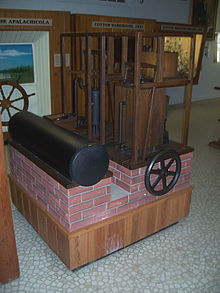History
| This section may contain inappropriate or misinterpreted citations that do not verify the text. (September 2010) |
Mechanical cooling
In the 17th century, Cornelis Drebbel demonstrated "turning Summer into Winter" for James I of England by adding salt to water.[5]
In 1758, Benjamin Franklin and John Hadley, a chemistry professor at Cambridge University, conducted an experiment to explore the principle of evaporation as a means to rapidly cool an object. Franklin and Hadley confirmed that evaporation of highly volatile liquids such as alcohol and ether could be used to drive down the temperature of an object past the freezing point of water. They conducted their experiment with the bulb of a mercury thermometer as their object and with a bellows used to "quicken" the evaporation; they lowered the temperature of the thermometer bulb down to −14 °C (7 °F) while the ambient temperature was 18 °C (64 °F). Franklin noted that, soon after they passed the freezing point of water 0 °C (32 °F), a thin film of ice formed on the surface of the thermometer's bulb and that the ice mass was about a quarter-inch thick when they stopped the experiment upon reaching −14 °C (7 °F). Franklin concluded, "From this experiment one may see the possibility of freezing a man to death on a warm summer's day"...[6]
In 1820, British scientist and inventor Michael Faraday discovered that compressing and liquefying ammonia could chill air when the liquefied ammonia was allowed to evaporate. In 1842, Florida physician John Gorrie used compressor technology to create ice, which he used to cool air for his patients in his hospital in Apalachicola, Florida.[7] He hoped eventually to use his ice-making machine to regulate the temperature of buildings. He even envisioned centralized air conditioning that could cool entire cities.[8] Though his prototype leaked and performed irregularly, Gorrie was granted a patent in 1851 for his ice-making machine. His hopes for its success vanished soon afterwards when his chief financial backer died; Gorrie did not get the money he needed to develop the machine. According to his biographer, Vivian M. Sherlock, he blamed the "Ice King", Frederic Tudor, for his failure, suspecting that Tudor had launched a smear campaign against his invention. Dr. Gorrie died impoverished in 1855, and the idea of air conditioning faded away for 50 years.
James Harrison's first mechanical ice-making machine began operation in 1851 on the banks of the Barwon River at Rocky Point in Geelong (Australia). His first commercial ice-making machine followed in 1854, and his patent for an ether vapor-compression refrigeration system was granted in 1855. This novel system used a compressor to force the refrigeration gas to pass through a condenser, where it cooled down and liquefied. The liquefied gas then circulated through the refrigeration coils and vaporised again, cooling down the surrounding system. The machine employed a 5 m (16 ft.) flywheel and produced 3,000 kilograms (6,600 lb) of ice per day.
Though Harrison had commercial success establishing a second ice company back in Sydney in 1860, he later entered the debate over how to compete against the American advantage of unrefrigerated beef sales to the United Kingdom. He wrote Fresh Meat frozen and packed as if for a voyage, so that the refrigerating process may be continued for any required period, and in 1873 prepared the sailing ship Norfolk for an experimental beef shipment to the United Kingdom. His choice of a cold room system instead of installing a refrigeration system upon the ship itself proved disastrous when the ice was consumed faster than expected.

Tidak ada komentar:
Posting Komentar